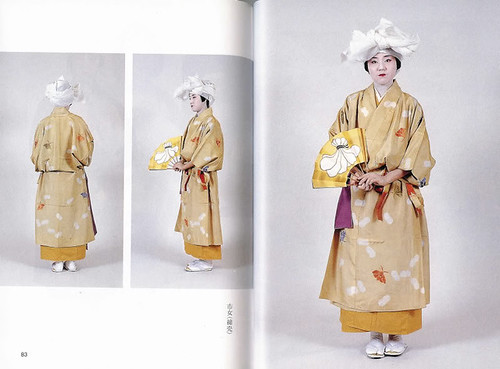
百花斉放 ひゃっかせいほう HYAKKA SEIHOU “A hundred flowers blooming” A blooming of the arts and sciences. I thought it was a fine sentiment to begin Inktober with.
I won’t be doing this every time, but I wanted to show a little of the background work that goes into this seemingly simple piece. Alas, I had no one around to take pictures as I actually brushed things out, but here’s an outline of the process.
百花斉放 is a yojijukugo, a four kanji character compound that acts as a proverb. There are thousands of these in the Japanese language, many of which came from Chinese works, which can make them a little challenging to translate. Jim Breen has a collection of them here, although I’m not sure what order he used. I found mine via this book here which was put together by my shodo teacher, Tony K. Skeen. In this book, the yojijukugo are in kana order (a,i,u,e,o/ ha, hi, fu, he, ho…etc) and therefore easier to find.
The first thing I do when I find a phrase I want to brush out is to cross-reference. In doing so, I double-check the translation, figure out the stroke order, and find examples of the style I want to brush out. This takes me across at least 3 or 4 dictionaries (or the internet if I can’t find what I need in the books).

I use the New Nelsons Japanese-English Character dictionary, Hadamitsky/Spahn’s A Guide to Writing Kanji and Kana for stroke order, and a 3-style Japanese Calligraphy Dictionary 現代書道三体字典 : コンパクト Gendai shodō santai jiten : Konpakuto (Modern shodo in three styles dictionary, compact version) by KISEKI Motohashi for the style examples.
Side note: if I am working on something for an SCA project, I will usually also try to find some style examples from extant historical documents. I know that there are some historical Japanese calligraphic dictionaries (I have seen a few), but with my middle-school Japanese, it’s hard for me to track them down easily.
So in the next four pictures, I cross reference each kanji from Hadamitsky/Spahn to the Gendai shodo santai jiten. I skipped taking pictures of looking up things in the Nelsons as it is a thick book and I couldn’t balance the camera!

Hyaku 百 meaning “100”
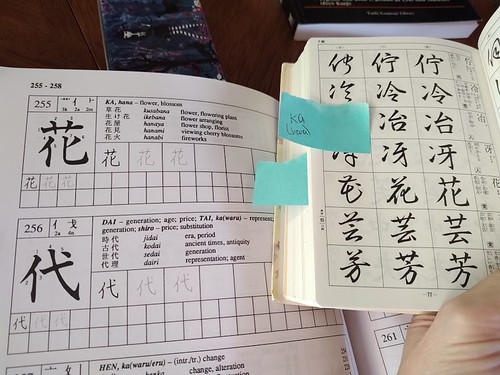
Ka 花, which is the ON (Sino-Japanese) pronunciation of hana, meaning “Flower”

Sei 斉 meaning “equal” or in the case “all at one time”

Hou 放 meaning “release” or “set free”
So literally, one hundred flowers released at the same time, or as we might say more poetically in English “one hundred flowers blooming” or “a hundred flowers blossoming”. Translation: it’s both an art and a science! In this instance, the phrase is referring to a blossoming of the arts and sciences, like what we might call a golden era or renaissance.
I’d like you to notice a few things in these pictures. Compare the computer kanji that is in this entry to the written kanji in the larger book, and then the three examples in the smaller book. THIS is the difference between just writing kanji and doing calligraphy. One of the things I see so often is people using computer kanji as their basis for kanji used in SCA scrolls. NO. PLEASE DON’T DO THIS. It’s like using the Times New Roman font as an exemplar for a 14th century scroll!!
If you notice, the smaller book shows three types of writing for each kanji. From right to left (and remember, the Japanese read right to left, not left to right), the styles are Kaisho (block script), gyousho (semi-cursive script), and sosho (cursive script).
While I chose to use sosho for my phrase today, I still practiced the kaisho. The reason for that is to get the stroke order correct and notice how some of the elements transmute when used in cursive. The gyousho is very helpful for seeing how the change happened, and while it was and is a widely used form, I don’t like it much.
So next, I had to consider the paper I was planning to use. A merchant had sent me some samples of this handmade washi paper and I thought it might be nice to try. However, I had to take into consideration that the size is smaller than the paper I usually use, as seen below:

I often use phone book or newspaper to practice kanji on when I am trying to get a sense of the shape. Here’s a comparison of my small phone book paper to the sheet I wanted to use. I would have to keep the size difference in mind as I practiced.

Again, I apologize for the lack of in-situ pictures. Here’s my normal set-up when doing brush calligraphy:
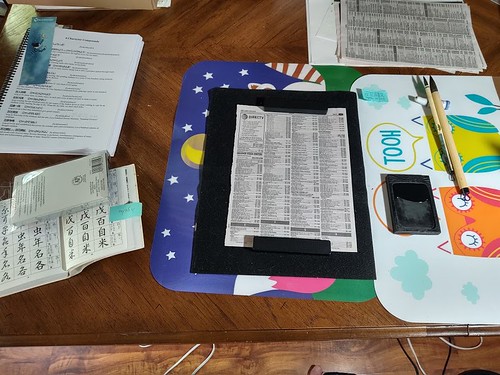
Examples to the left so I can see them, brushes and suzuri (ink stone) to the right, paper up top. Bunshin paperweights hold the paper in place and below the paper is a shitajiki, felt that absorbs ink since it tends to seep through the paper. The garish plastic placemats are extra protection since I’m doing this work on my dining table!
So here are some practice runs on the various kanji, in both kaisho and sosho forms:
HYAKU
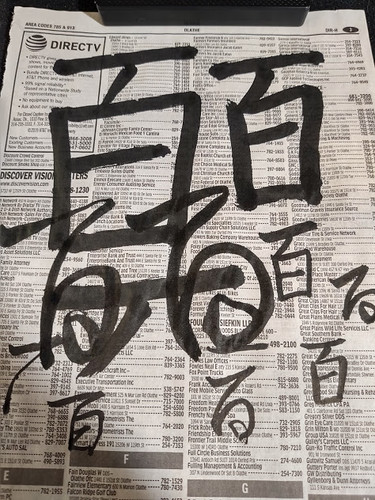

KA

SEI

HOU

And a few run-throughs of Hyakka Seihou. I’m messing a bit with the placement of the kanji in reference to each other. Sei especially wants to run larger than the others and is being a pain!
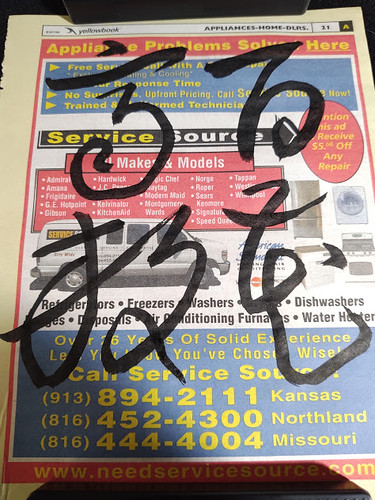


And finally, brushing the phrase on the special washi paper. I was actually going to do a couple of runs at this (because I wasn’t sure how the paper would take the ink), but the first one came out fairly well.
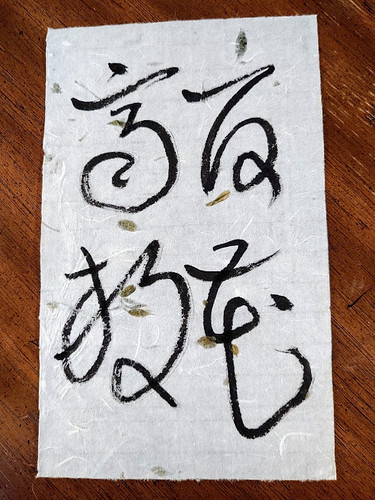
I actually wanted to do more practices, but honestly, there’s just a time when you have to do it and be done. It’s never going to be perfect to my eyes. The one thing I might have changed is leaving a bit more room at the left side for a seal signature. However, since I haven’t finished designing and carving my inkan (seal) yet, I felt the point was moot.
Hope this walk-through helps explain the process. The result is very simple and understated but there is a lot of work that goes on in the background!
